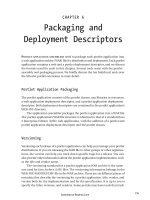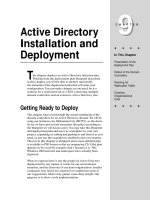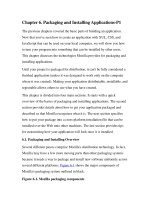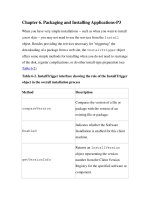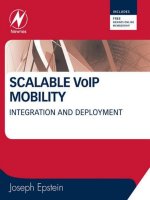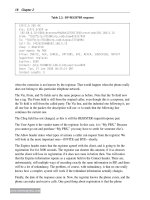Packaging and Deployment Descriptors
Bạn đang xem bản rút gọn của tài liệu. Xem và tải ngay bản đầy đủ của tài liệu tại đây (779.4 KB, 26 trang )
159
CHAPTER 6
Packaging and
Deployment Descriptors
P
ORTLET APPLICATION ASSEMBLERS
need to package each portlet application into
a web application archive (WAR) file for distribution and deployment. Each portlet
application contains a web and a portlet deployment descriptor, and we discuss
the formats used for each in this chapter. Several tools assist with the portlet
assembly and packaging process. We briefly discuss the Ant build tool, and cover
the XDoclet portlet extensions in more detail.
Portlet Application Packaging
The portlet application consists of the portlet classes, any libraries or resources,
a web application deployment descriptor, and a portlet application deployment
descriptor. Both deployment descriptors are contained in the portlet application’s
WEB-INF directory.
The application assembler packages the portlet application into a WAR file.
The portlet application’s WAR file structure is identical to that of a standard Java
2 Enterprise Edition (J2EE) web application, with the addition of a portlet.xml
portlet application deployment descriptor and the portlet classes.
Versioning
Versioning each release of a portlet application can help you manage your portlet
distributions. If you are releasing the WAR file to other groups or other organiza-
tions, the version can help you track down specific bugs for a release. You can
also provide other information about the portlet application implementation, such
as the title and vendor name.
The versioning standard for a portlet application WAR archive is the same
one used for Java Archive (JAR) files. The versioning information belongs in the
WEB-INF/MANIFEST.MF file in the WAR archive. There are six different pieces of
metadata that describe the versioning for a portlet application: title, vendor, and
version both for the implementation and for the specification. It is up to you to
specify the titles, versions, and vendors. Some portals may have tools that track
2840ch06.qxd 7/13/04 12:44 PM Page 159
Download at Boykma.Com
Chapter 6
160
these versions for you, and they can be useful if there is no other version infor-
mation in the WAR file.
Here is an example MANIFEST.MF file for a portlet application:
Manifest-Version: 1.0
Name: DocumentManagementPortlet
Specification-Title: WebDAV
Specification-Vendor: WebDAV
Specification-Version: 1.0
Implementation-Title: DocumentationManagementPortlet
Implementation-Vendor: PortalBook.com
Implementation-Version: 0.9.3
Portlet Application Deployment Descriptor Structure
An XML Schema named portlet-app_1_0.xsd specifies the structure of the portlet
application deployment descriptor. Your portal should include a copy of this
schema, either as documentation or for deployment descriptor documentation.
The full schema is too large to reprint in this book (over 15 pages), but we used
Altova’s XML Spy XML editor to generate diagrams from the schema. We discuss
each element in the schema, and give a pointer to the relevant chapter of this
book. Future versions of the portlet API may extend or change elements of this
schema, so when you upgrade to a portal that supports a newer version, check
the release notes to see what changed.
portlet-app
The root element of the portlet application deployment descriptor is the
<portlet-app>
element. The
<portlet-app>
element contains any portlet defini-
tions, custom portlet modes or window states, the supported user attributes
for the portlet application, and the security constraints. This element represents
a distinct portlet application that is self-contained and can be deployed on a por-
tal with no dependencies. Figure 6-1 shows the XML Schema for this element.
There are two attributes on the
<portlet-app>
element. The first attribute
is named
version
, and it is required. The value of the
version
attribute is the version
of the portlet API that this portlet application supports. The deployment descrip-
tor must be valid with that version of the portlet application deployment descriptor
schema, but it may be invalid with future releases. Until a new version of the
portlet API is released, this value will be 1.0. The other attribute,
id
, is optional.
2840ch06.qxd 7/13/04 12:44 PM Page 160
Download at Boykma.Com
Packaging and Deployment Descriptors
161
portlet:portlet-appType
portlet-app
0..∞
portlet
—
—
+
0..∞
custom-portlet-mode
+
0..∞
custom-window-state
+
0..∞
user-attribute
+
0..∞
security-constraint
+
Figure 6-1. The
<portlet-app>
XML Schema
The
<portlet-app>
element may contain
<portlet>
elements, which represent
portlet classes,
<custom-portlet-mode>
elements,
<custom-window-state>
elements,
<user-attribute>
elements, or
<security-constraint>
elements.
<portlet-app xmlns=" ➥
version="1.0" ➥
xmlns:xsi=" ➥
xsi:schemaLocation=" ➥
/><portlet>
...
</portlet>
</portlet-app>
portlet
The
<portlet>
element (see Figure 6-2) represents a portlet class and all of its
metadata. The only attribute on the
<portlet>
element is
id
, and it is optional.
2840ch06.qxd 7/13/04 12:44 PM Page 161
Download at Boykma.Com
Chapter 6
162
portlet:portletType
0..∞
description
0..∞
display-name
portlet-name
0..∞
init-param
0..∞
supported-locale
0..∞
portlet
0..∞
security-role-ref
1..∞
supports
portlet-class
expiration-cache
resource-bundle
+
portlet-info
+
+
portlet-preferences
+
portlet-info
+
—
—
+
—
—
Figure 6-2. The
<portlet>
XML Schema
2840ch06.qxd 7/13/04 2:55 PM Page 162
Download at Boykma.Com
Packaging and Deployment Descriptors
163
Each portlet may have an optional description, which is specified in the
<description>
element. Portal administration tools use the description to give
some context about the portlet to a portlet application deployment.
TIP
The <description> element is a child of many of the tags in the portlet
deployment descriptor. Its use is optional, but it is very handy for documenta-
tion or portlet deployment tools.
The
<portlet-name>
element is required for the portlet. Each portlet’s name
in the portlet application has to be unique. This name should not contain any
spaces or non-web-friendly special characters.
The
<display-name>
element provides a human-readable name for portal admin-
istration tools. It is optional.
The class name of the portlet belongs in the
<portlet-class>
element, which
takes a fully qualified Java class name, as shown here:
<portlet>
<description>Preferences Validation Portlet</description>
<portlet-name>PreferencesValidationPortlet</portlet-name>
<display-name>Preferences Validation Portlet</display-name>
<portlet-class>
com.portalbook.portlets.PreferencesValidationPortlet</portlet-class>
....
</portlet>
Each portlet may have zero or more portlet initialization parameters, which
are used to provide configuration information for all users. The
<init-param>
element (see Figure 6-3) has three child elements:
<description>
,
<name>
, and
<value>
. The
<name>
and
<value>
elements are required. For more on initialization
parameters, see Chapter 7.
2840ch06.qxd 7/13/04 12:44 PM Page 163
Download at Boykma.Com
Chapter 6
164
portlet:init-paramType
0..∞
description
name
0..∞
init-param
—
—
value
Figure 6-3. The
<init-param>
XML Schema
<init-param>
<name>indexPath</name>
<value>/java/index</value>
</init-param>
<init-param>
<name>repository</name>
<value>engineering</value>
</init-param>
The portlet container may cache the output of a portlet. The portlet defines
the timeout it expects for the cache in the
<expiration-cache>
element. If the
value is -1, the cached output is always valid:
<expiration-cache>0</expiration-cache>
The portlet may support more than one Multipurpose Internet Mail Extensions
(MIME) type, and for each MIME type, the portlet needs to tell the portlet container
which portlet modes are valid. These could be any of the standard portlet modes
(VIEW, EDIT, HELP), or custom modes that are specified later in the deployment
descriptor. Each MIME type should be specified only once, and there must be at
least one MIME type for each portlet. The
<supports>
element (see Figure 6-4) groups
MIME types,
<mime-type>
, and portlet modes,
<portlet-mode>
. The portlet modes
should be a comma-delimited list of valid portlet modes. For more on portlet modes,
see Chapter 4.
2840ch06.qxd 7/13/04 12:44 PM Page 164
Download at Boykma.Com
Packaging and Deployment Descriptors
165
portlet:supportsType
0..∞
portlet-mode
1..∞
supports
—
—
mime-type
Figure 6-4. The
<supports>
XML Schema
<supports>
<mime-type>text/html</mime-type>
<portlet-mode>edit</portlet-mode>
<portlet-mode>help</portlet-mode>
<portlet-mode>view</portlet-mode>
</supports>
You may specify which locales the portlet supports with the
<supported-locale>
element. The element should contain the name of a valid Java locale. There can
be more than one supported locale for a portlet. The portal may use these values
to localize content for the end user:
<supported-locale>en</supported-locale>
The portlet metadata can also be localized with a resource bundle. The resource
bundle should contain the information from the
<portlet-info>
tag (Figure 6-5),
specified as javax.portlet.title, javax.portlet.short-title, and javax.portlet.keywords.
The
<resource-bundle>
tag should contain the class name of the resource bundle.
The bundle should be in the portlet application’s classpath:
<resource-bundle>com.portalbook.Messages</resource-bundle>
portlet:portlet-infoType
title
short-title
portlet-info
—
—
keywords
Figure 6-5. The
<portlet-info>
XML Schema
2840ch06.qxd 7/13/04 3:32 PM Page 165
Download at Boykma.Com
Chapter 6
166
portlet:portlet-preferencesType
preferences-validator
portlet-preferences
—
—
0..∞
preference
+
Figure 6-6. The
<portlet-preferences>
XML Schema
The
<portlet-info>
element represents the portlet metadata. There are three
XML child elements that contain information:
<title>
,
<short-title>
, and
<keywords>
. The portlet’s title bar uses the value in the
<title>
element, although
some portlets will change the title dynamically. The short title is for mobile phones,
PDAs, or other portal clients that do not have a lot of room for a title to display.
<portlet-info>
<title>Taxonomy Portlet</title>
<short-title>Taxonomy</short-title>
<keywords>Taxonomy,Lucene</keywords>
</portlet-info>
The
<portlet-preferences>
element (Figure 6-6) contains zero or more
<preference>
elements and an optional
<preferences-validator>
element. The
<preferences-validator>
value should be the class name for a validator class.
The
<preference>
element has a child
<name>
element, which is required, and
zero or more optional initial values. There is also a read-only flag for preferences
that cannot be modified. The preference value must be set in the deployment
descriptor.
Each portlet preference name must be unique for the portlet. You may have
portlet preferences with the same name for two or more portlets in a portlet
application. For more on portlet preferences, see Chapter 7.
<portlet-preferences>
<preference>
<name>bookmark</name>
<value>/content/marketing</value>
</preference>
<preferences-validator>
com.portalbook.portlets.TaxonomyValidator
</preferences-validator>
</portlet-preferences>
2840ch06.qxd 7/13/04 12:44 PM Page 166
Download at Boykma.Com
Packaging and Deployment Descriptors
167
The
<security-role-ref>
element (Figure 6-7) maps portlet security roles to
web application security roles. For more on portlet application security, see
Chapter 8.
<security-role-ref>
<role-name>Administrator</role-name>
<role-link>admin</role-link>
</security-role-ref>
custom-portlet-mode
The
<custom-portlet-mode>
element (Figure 6-8) defines a custom portlet mode that
this portlet supports. Each portlet application can have as many custom portlet
modes as it needs. The
<custom-portlet-mode>
element has a
<portlet-mode>
ele-
ment that contains the name of the portlet mode, such as PRINT. The
<description>
element is optional.
portlet:security-role-refType
role-link
role-name
—
0..∞
description
0..∞
security-role-ref
—
Figure 6-7. The
<security-role-ref>
XML Schema
portlet:custom-portlet-modeType
portlet-mode
—
0..∞
description
0..∞
custom-portlet-mode
—
Figure 6-8. The
<custom-portlet-mode>
XML Schema
2840ch06.qxd 7/13/04 3:32 PM Page 167
Download at Boykma.Com
Chapter 6
168
portlet:custom-window-stateType
window-state
—
0..∞
description
0..∞
custom-window-state
—
Figure 6-9. The
<custom-window-state>
XML Schema
For more on custom portlet modes, see Chapter 4.
<custom-portlet-mode>
<portlet-mode>PRINT</portlet-mode>
</custom-portlet-mode>
custom-window-state
The
<custom-window-state>
element (Figure 6-9) defines a custom window state
supported by this portlet. The portlet application can have zero or more custom
window states. The
<custom-window-state>
element has a
<window-state>
element
that contains the name of the window state, such as ICON. The
<description>
element is optional.
For more on custom window states, see Chapter 4.
<custom-window-state>
<window-state>docked</window-state>
</custom-window-state>
user-attribute
The portlet application can access information about the user, but the requested
attributes must be explicit in the portlet deployment descriptor. Each user attribute
the portlet requires needs to be defined in portlet.xml as a
<user-attribute>
element
(Figure 6-10). The user attributes are optional, and there may be an unlimited num-
ber of them.
2840ch06.qxd 7/13/04 3:32 PM Page 168
Download at Boykma.Com
